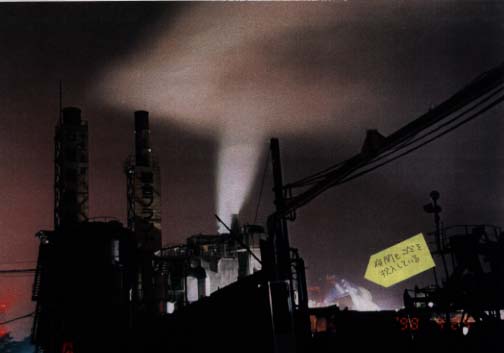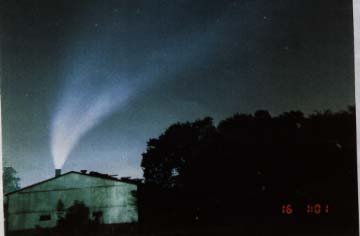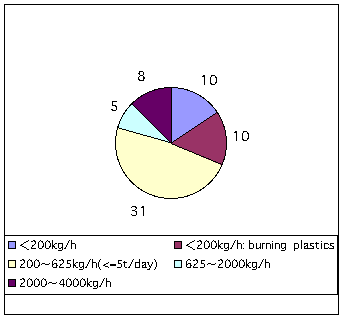
Data on incinerators in the Tokorozawa area
@ There are 64 licensed industrial waste
incinerators operating in the Tokorozawa area. Of the 64 incinerators,
51 have capacities below 5 tons per day. Until a 1997 amendment
to the Waste Management Regulations, incinerators with capacities
below than 5 tons per day remained outside the regulations.
In the graph below, we can see the results of Saitama PrefectureÕs
environmental policy. The authorities repeatedly encouraged notorious
open-burning violators to erect incinerators with capacities below
5 tons per day, which at that time were unregulated by law.

@Due to two amendments in Saitama prefectureÕs
waste management regulations enacted in 1997 and 1998, which strengthened
regulations in incinerator construction specifications and operation
maintenance, many incinerators have shut down operations, either
temporarily or permanently. Citizens were led to believe that
environmental conditions would improve. Yet residents living near
incinerators, oppressed by smoke, have found the incidence of
pollution to be more serious than ever.
Presented below are analyses results of data compiled from incinerator
permit applications on file at the prefecture, and from data culled
from incinerator logbooks during citizen inspections.
PC. Examining temporary and permanent shutdowns, and upgrades
in incinerator capacity.
Operational status of incinerators in the Tokorozawa area (by
number of incinerator)
@ Saitama Prefecture reports that out of the 64 licensed industrial waste incinerators in the Tokorozawa area, 16 have shut down permanently, 10 have shutdown temporarily, one is being rebuilt, and 37 are operating as usual. Citizens report that 3 out of the 10 temporary shutdowns have no apparent plans to resume operations. The plans of the remaining 7 facilities are unknown.
@From the above graph, we can see that
even though 16 permanent shutdowns have been reported, as the
incinerators were the smaller type, overall there has only been
an 8% reduction in the total amount of wastes incinerated.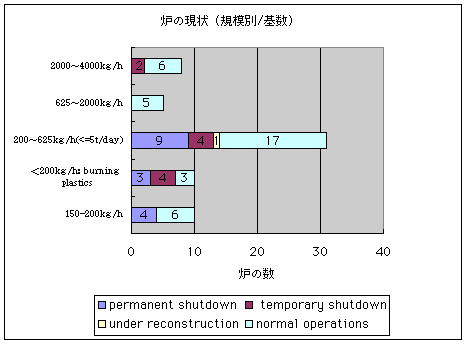
@From the permit applications filed with
the prefecture, we can see that during the 1990Õs there was a
drastic increase in the overall amount of incineration. In 1997,
the 64 industrial waste incinerators collectively burned an average
of 407 tons per day. Between 1997 and 1999, there were 16 permanent
shutdowns, with a collective decrease in incineration of about
35 tons per day. But in 1998, which falls in the same period,
an existing facility, Yamaichi Shoji, was granted a permit to
rebuild, increasing the facilityÕs capacity by 20 tons per day.
So the actual net decrease in total wastes burned works out to
be around 15 tons per day.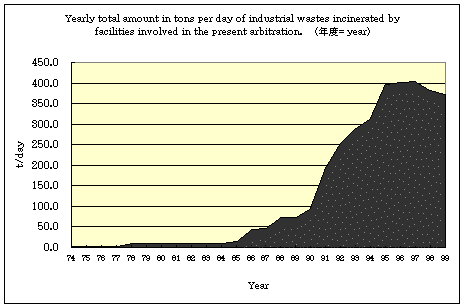
QCAbout industrial waste incinerator operating conditions
Standards for incineration design and operations were strengthened
in December 1998. In April 1999, waste storage regulations were
also strengthened. Yet recently the smoke has returned to wreath
the Kunugiyama area, expecially in the early morning hours. Behind
the seeming optimism of strengthened regulations lies the darker
reality of night burning, incinerators operating with hatches
open, and refuse dumped into the hatch while the incinerator is
in operation. Poor operational procedures such as these are responsible
for airborne ash, black smoke, and chloride smells. And still
nothing has been done about the oversized heaps of refuse, which
are now flagrantly in violation of waste storage regulations.
PjComplete incineration and temperature
control
Nearly all of the incinerators in the Tokorozawa area are
batch-mode types designed to operate for 8 hours per day. Only
one facility, which operates two furnaces, is equipped for continuous-
mode incineration. None of the incinerators is equipped with a
grate to agitate or mix the refuse to ensure even burning. Complete
burning is impossible to attain under these circumstances, and
during the daily start-ups and shutdowns, large amounts of dioxins
may be produced. In order to attain complete combustion, the prefecture
advises: ŅFill the furnace with the appropriate amount of refuse
once per day. Use the auxiliary burner to assist combustion. Do
not open the hatch until the furnace has achieved complete burnout.
If the temperature in the furnace drops below 800, use the auxiliary
burner to raise the temperature. Toward the end of incineration
use the auxiliary burner once again to insure complete burnout.Ó
However, because there are so many incinerators in this area,
the ŅadviceÓ and ŅoverseeingÓ capabilities of the prefecture authorities
are in question. The incinerators, unequipped with agitator grates,
cannot possibly burn waste effectively. On inspection of the ash,
partially burned lumps of matter are clearly visible to the eye,
and the amount of partially burned matter exceeds the 10% limit
imposed by waste management regulations. The authorities show
no signs of acting on this violation.
P24. What the temperature
logs reveal about operating conditions
The recent amendment to the waste management regulations allows
citizens to inspect maintenance logs kept by industrial waste
incineration facilities. On inspection, temperature measurement
logs revealed that it was common practice for operators the open
the hatch while the furnace was in the middle of the burning process.
The logs also revealed that operators fed the furnaces several
times per day, did not ensure complete burnout, and did not comply
with registered operating hours. Some operators had even turned
off the devices to measure temperature during operations. The
waste management regulations were strengthened over a half a year
ago. What are the authorities doing?

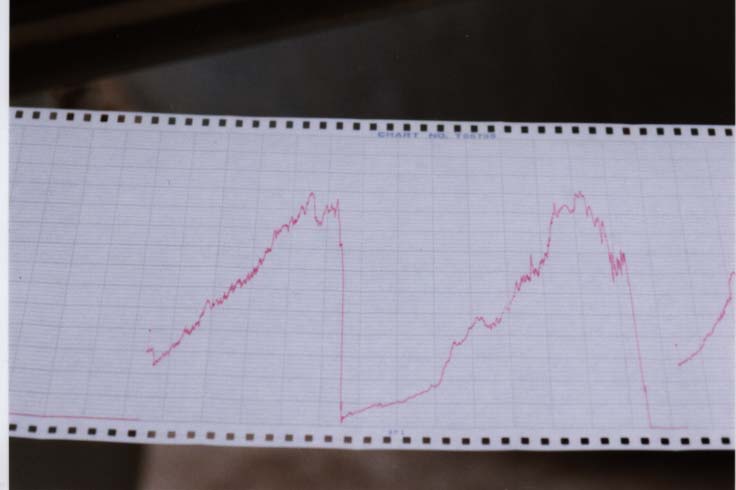
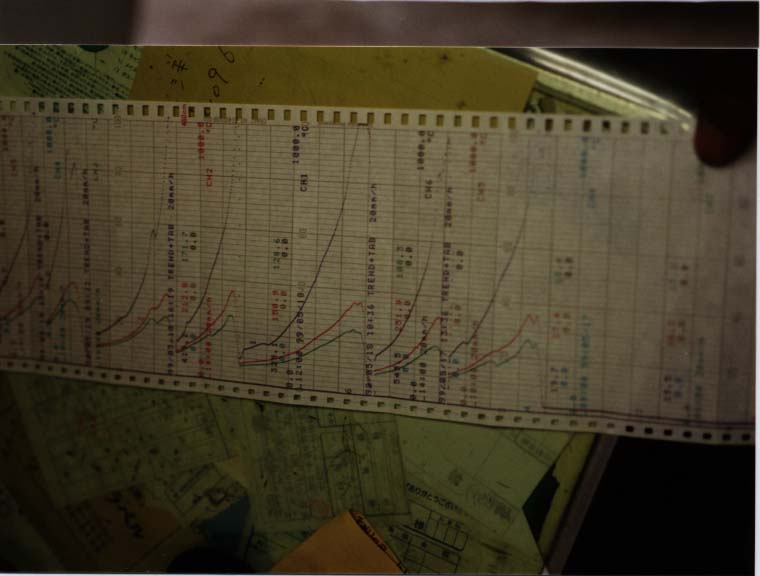
Temperature measurement graphs show a pattern which concurs
with feeding the furnace in the middle of a burn cycle. This pattern
repeats two or three times per day. It is also obvious that steady
temperatures of at least 800 are not being maintained. The graph
on the right is from a facility that admits turning off the recording
device as soon as the temperature reaches 800.
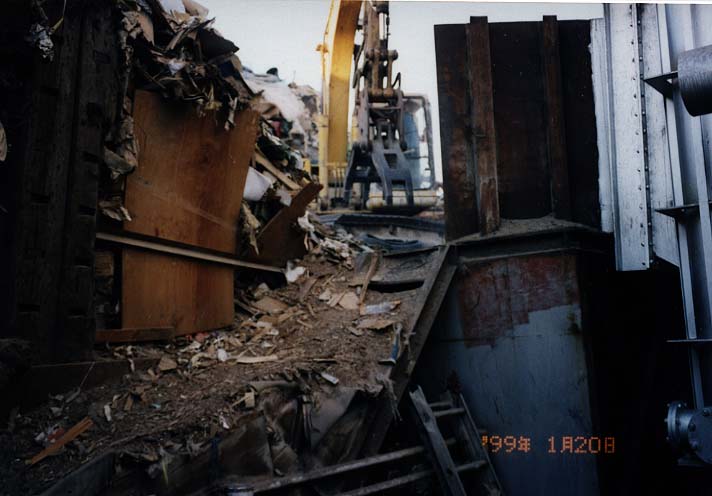
The condition of incinerator ash (incomplete burning)
From the looks of the partially burned objects in the ash,
it is obvious that burning is incomplete. Not one of the facilities
in the area has a roof over the ash storage receptacles, which
leaves the ash open to the effects of rain and wind. We remain
apprehensive about seepage and windborne spread of dangerous substances.
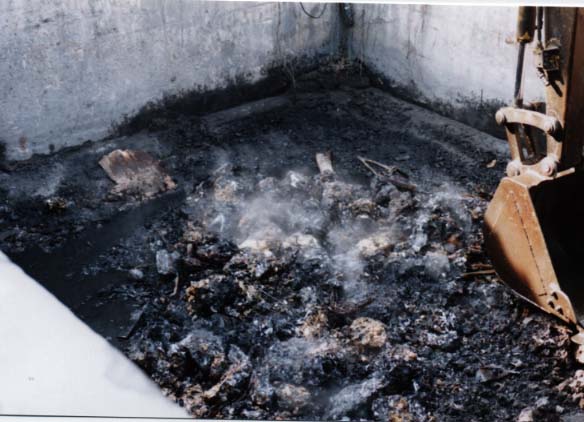
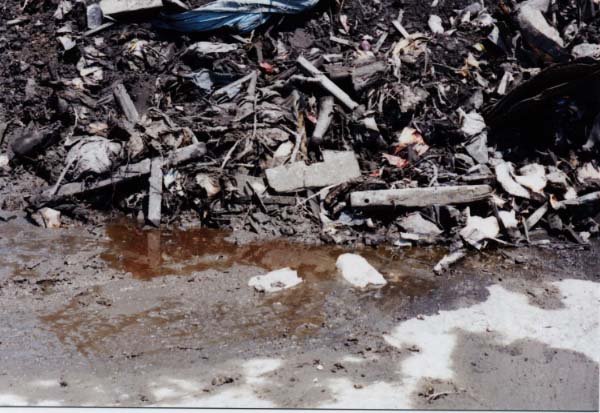
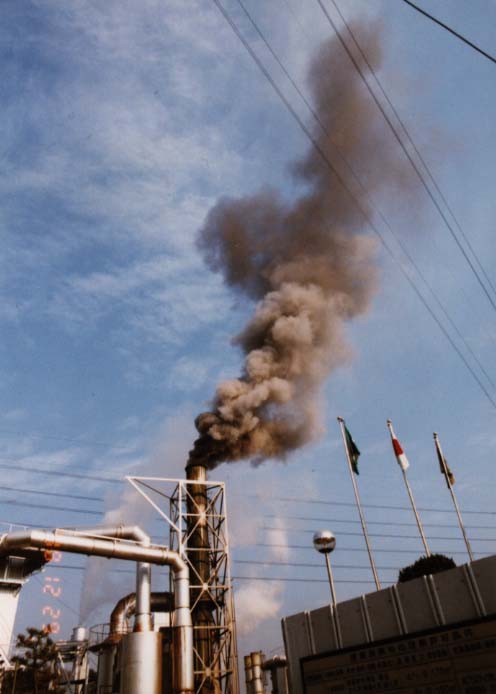
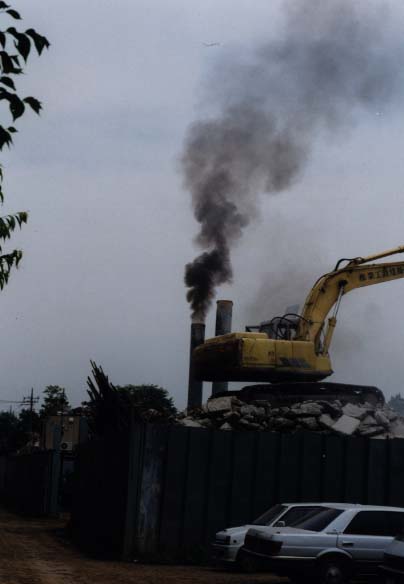
28. Citizens witness smoke black with fly ash belching from the smokestacks. Black smoke is emitted in the mornings and evenings during start-ups and shutdowns, and during operations when the hatch is opened to feed the furnace.
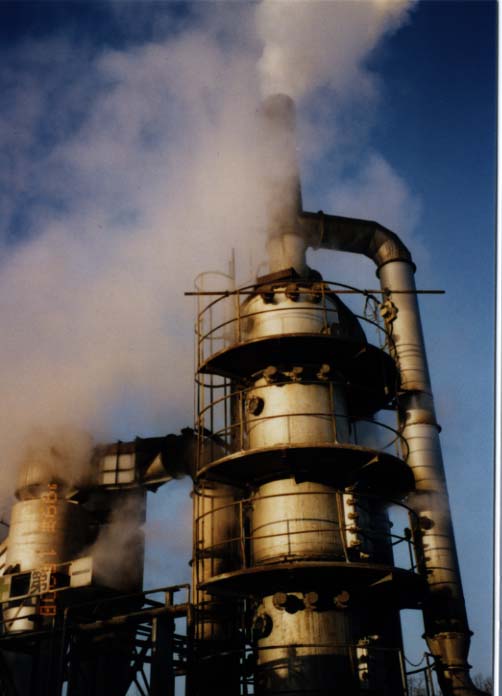
In August 1998, this incineratorÕs hydrogen chloride emissions were measured at 6100ppm (the regulatory guidelines set the limit for HC emissions at 700ppm). Because the test was voluntary, the prefecture says they have not offered any guidance on this matter. Citizens visiting the facility report chloride smells in the vicinity.
S@ Night operations
After citizens and authorities have gone to sleep, the facilities
can operate as they please. In the mornings the area is wreathed
with smoke. Operational hours written on the incinerator permits
are flagrantly ignored.
